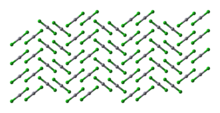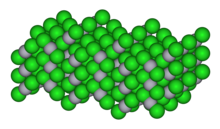Mercury(II) chloride
 | |
 | |
 | |
| Names | |
|---|---|
| IUPAC names
Mercury(II) chloride
Mercury dichloride | |
| Other names
Mercuric chloride
Corrosive sublimate | |
| Identifiers | |
| ECHA InfoCard | 100.028.454 |
| EC Number |
|
| RTECS number |
|
| UN number | 1624 |
CompTox Dashboard (EPA)
|
|
| Properties | |
| HgCl2 | |
| Molar mass | 271.52 g/mol |
| Appearance | white solid |
| Density | 5.43 g/cm3 |
| Melting point | 276 °C (529 °F; 549 K) |
| Boiling point | 304 °C (579 °F; 577 K) |
| 7.4 g/100 ml (20 °C) | |
| Solubility | soluble in alcohol, ether, acetone, ethyl acetate slightly soluble in benzene, CS2 |
| Acidity (pKa) | 3.2 (0.2M solution) |
| Structure | |
| orthogonal | |
| linear | |
| linear | |
| zero | |
| Hazards | |
| NFPA 704 (fire diamond) | |
| Flash point | Non-flammable |
| Related compounds | |
Other anions
|
Mercury(II) fluoride Mercury(II) bromide Mercury(II) iodide |
Other cations
|
Zinc chloride Cadmium chloride Mercury(I) chloride |
Except where otherwise noted, data are given for materials in their standard state (at 25 °C [77 °F], 100 kPa).
| |
Mercury(II) chloride or mercuric chloride (formerly corrosive sublimate), is the chemical compound with the formula HgCl2. This white crystalline solid is a laboratory reagent. It was formerly used more widely, however it is one of the most toxic forms of mercury because it is more soluble than most other forms in water. It is an ionic compound.
Production and basic properties
Mercuric chloride is not a salt but a linear triatomic molecule, hence its tendency to sublime. In the crystal, each mercury atom is bonded to two close chloride ligands with Hg---Cl distance of 2.38 Å; four more chlorides are more distant at 3.38 Å.[1]
Mercuric chloride is obtained by the action of chlorine on mercury or mercury(I) chloride, by the addition of hydrochloric acid to a hot, concentrated solution of mercury(I) compounds such as the nitrate:
- HgNO3 + 2 HCl → HgCl2 + H2O + NO2,
Heating a mixture of solid mercury(II) sulfate and sodium chloride also affords volatile HgCl2, which sublimes and condenses in the form of small rhombic crystals.
Its solubility increases from 6% at 20 °C to 36% in boiling water. In the presence of chloride ions, it dissolves to give the tetrahedral coordination complex [HgCl4]2-.
Applications
The main application of mercuric chloride is as a catalyst for the conversion of acetylene to vinyl chloride, the precursor to polyvinylchloride:
- C2H2 + HCl → CH2=CHCl
For this application, the mercuric chloride is supported on carbon in concentrations of about 5 weight percent. This technology has been eclipsed by the thermal cracking of 1,2-dichloroethane. Other significant applications of mercuric chloride include its use as a depolarizer in batteries and as a reagent in organic synthesis and analytical chemistry (see below).[2] It is being used in plant tissue culture for surface sterilisation of explants such as leaf or stem nodes.
As a chemical reagent
Mercuric chloride is occasionally used to form an amalgam with metals, such as aluminium. Upon treatment with an aqueous solution of mercuric chloride, aluminium strips quickly become covered by a thin layer of the amalgam. Normally, aluminium is protected by a thin layer of oxide making it inert. Once amalgamated, aluminium can undergo a variety of reactions. For example, it will dissolve in water (this can be dangerous, as hydrogen gas and heat are generated). Halocarbons react with amalgamated aluminium in the Barbier reaction. These alkylaluminium compounds are nucleophilic and can be used in a similar fashion to the Grignard reagent. Amalgamated aluminium is also used as a reducing agent in organic synthesis. Zinc is also commonly amalgamated using mercuric chloride.
Mercuric chloride is used to remove dithiane groups attached to a carbonyl in an umpolung reaction. This reaction exploits the high affinity of Hg2+ for anionic sulfur ligands.
Historic use in photography
Mercury(II) chloride was used as a photographic intensifier to produce positive pictures in the collodion process of the 1800s. When applied to a negative, the mercury(II) chloride whitens and thickens the image, thereby increasing the opacity of the shadows and creating the illusion of a positive image.[3]
Historic use in preservation
For the preservation of anthropological and biological specimens during the late 19th and early 20th centuries, objects were dipped in or were painted with a "mercuric solution". Objects in drawers were protected by scattering crystalline mercuric chloride over them.[4] It finds minor use in tanning, and wood was preserved by kyanizing (soaking in mercuric chloride).[5] Mercuric chloride was one of the three chemicals used for railroad tie wood treatment between 1830 and 1856 in Europe and the United States. Limited railroad ties were treated in the United States until there were concerns over lumber shortages in the 1890s.[6] The process was generally abandoned because mercuric chloride was water soluble and not effective for the long term, as well as poisonous. Furthermore, alternative treatment processes, such as copper sulfate, zinc chloride, and ultimately creosote; were found to be less toxic. Limited kyanizing was used for some railroad ties in the 1890s and early 1900s.[7]
Historic use in medicine
Syphilis was frequently treated with mercuric chloride before the advent of antibiotics. It was inhaled, ingested, injected, and applied topically. Poisoning was so common that its symptoms were confused with those of syphilis.[8]
Toxicity
Mercuric chloride is highly toxic, not only acutely but as a cumulative poison.
References
- ^ Wells, A.F. (1984) Structural Inorganic Chemistry, Oxford: Clarendon Press. ISBN 0-19-855370-6.
- ^ Matthias Simon, Peter Jönk, Gabriele Wühl-Couturier, Stefan Halbach "Mercury, Mercury Alloys, and Mercury Compounds" in Ullmann's Encyclopedia of Industrial Chemistry 2006: Wiley-VCH, Weinheim. DOI: 10.1002/14356007.a16_269.pub2
- ^ Towler, J. (1864). Stereographic negatives and landscape photography. Chapter 28. In: The silver sunbeam: a practical and theoretical textbook of sun drawing and photographic printing. Retrieved on April 13, 2005.
- ^ Goldberg, L. (1996). A history of pest control measures in the anthropology collections, national museum of natural history, Smithsonian Institution.JAIC 35(1) 23–43. Retrieved on April 17, 2005.
- ^ Freeman, M.H. Shupe, T.F. Vlosky, R.P. Barnes, H.M. (2003). Past, present and future of the wood preservation industry. Forest Products Journal. 53(10) 8–15. Retrieved on April 17, 2005.
- ^ Pg. 19-75 "Date Nails and Railroad Tie Preservation" (3 vol.; 560 p.), published in 1999 by the Archeology and Forensics Laboratory, University of Indianapolis; Jeffrey A. Oaks
- ^ <History of Railroad Tie Preservation by Jeffrey A. Oaks, Univ. of Indiana, Pg. 20-30 and Pg. 64, Table I http://facstaff.uindy.edu/~%20oaks/Articles/History.pdf >
- ^ Pimple, K.D. Pedroni, J.A. Berdon, V. (2002, July 09). Syphilis in history. Poynter Center for the Study of Ethics and American Institutions at Indiana University-Bloomington. Retrieved on April 20, 2008.
External links
- This article incorporates text from a publication now in the public domain: Chisholm, Hugh, ed. (1911). Encyclopædia Britannica (11th ed.). Cambridge University Press.
{{cite encyclopedia}}: Missing or empty|title=(help) - Agency for toxic substances and disease registry. (2001, May 25). Toxicological profile for Mercury. Retrieved on April 17, 2005.
- National institutes of health. (2002, October 31). Hazardous substances data bank: Mercuric chloride. Retrieved on April 17, 2005.
- Young, R.(2004, October 6). Toxicity summary for mercury. The risk assessment information system. Retrieved on April 17, 2005.
- ATSDR - ToxFAQs: Mercury
- ATSDR - Public Health Statement: Mercury
- ATSDR - Medical Management Guidelines (MMGs) for Mercury (Hg)
- ATSDR - Toxicological Profile: Mercury
- International Chemical Safety Card 0979
- National Pollutant Inventory - Mercury and compounds Fact Sheet
- NIOSH Pocket Guide to Chemical Hazards
- Mercury chloride toxicity - includes excerpts from research reports.

